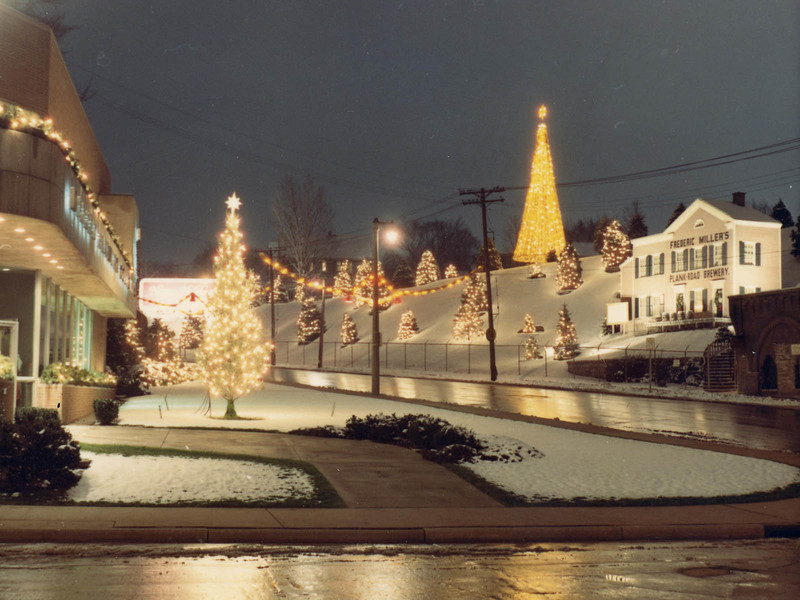Cheers! It's Bar Month at OnMilwaukee – so get ready to drink up more bar articles, imbibable stories and cocktailing content, brought to you by Potawatomi Casino Hotel and Miller Lite. Thirsty for more? To find even more bar content, click here!
“Lots of people see this as just a club. They don’t understand what it really is. They don’t realize what being gay in Milwaukee would have been like if there hadn’t been a La Cage.” – Jackie Roberts, 2009.
South Second Street was “just one wino bar after another” when George Prentice toured Niko’s, 801 S. 2nd St., for the first time.
Never having been inside the vintage 1888 mercantile (the history of which Bobby Tanzilo recently wrote about here), George couldn’t believe the condition it was in. Someone had covered up the original brick with metal panel siding, then painted the building fire engine red and then dropped the ceiling six feet. Over the years, the street had risen five feet, consuming four of the six original corner steps. The south half of the building was a Puerto Rican restaurant – filled with senior citizens playing dominoes – neighbored by a collapsing, abandoned tavern.
This was a strange place to a open a gay dance club, and word on the street was that George was nuts.
“There were people passed out sleeping in corners ... this big, old, dark place smelled of mold, beer, cigarette smoke and urine ... ratty, thrift store furniture held together with duct tape ... and I’m thinking: Do I really want to do this?”
Fortunately for Milwaukee, he did. After operating two legendary nightspots, the River Queen and the Circus Disco, George knew Milwaukee wanted something new, exciting and different. MTV was transforming dancefloors across America, and jukeboxes were no longer entertainment enough. No dance space could survive without video.
So, on March 6, 1984, La Cage Aux Folles opened as Milwaukee’s first true gay video bar. “Oh, it was just insane,” George remembered. “It was just overwhelming from the minute we opened the doors. We could not have imagined how starved Milwaukee was for something new. La Cage really reinvented this area. People would go to the YP on 1st Street, but they didn’t venture into the other bars. The area was really run down like you wouldn’t believe.”
George and partner Corey Grubb remember buying hundreds of pounds of shrimp for the grand opening and then realizing they had no way to serve it. So, the old clawfoot tub from the upstairs apartment was hauled downstairs and filled with shrimp!
“I’m so proud we opened up with great big windows,” said George. “None of the other gay bars had windows. They were all in the closet. They had a colored bulb, a 12-inch square glass window for the doorman. We had the audacity to hang a La Cage sign on one of the busiest corners in the city. People knew this place was different from day one.”
Open windows were a gamble in 1984. Many customers feared being seen in a gay bar and expected bullies to throw rocks or shoot guns through the windows. This didn’t happen. What did happen: Straight people came in large numbers, starting with single women and eventually married couples of all ages.
“I took some heat from the gay community,” said George, “and I would just answer with a question: You want to be free to go anywhere and be yourselves, but you want me to tell straight people they can’t come here and be themselves? What am I supposed to do? Ban straight people?”
Business was booming. La Cage responded by opening the “Dance, Dance, Dance” area in 1988, followed by the Jazz cocktail bar in 1989 and Grubb’s Pub in 1990. Near-constant remodeling and reinvention became a La Cage tradition, with guests constantly coming back to experience new spaces. La Cage became a membership club with “La Cage cards,” which allowed VIP admission policies and pricing, as well as occasional private events. Some cardholders still own their cards to this day.
“We had tunnel vision in the early years,” said George. “We had to completely redo the infrastructure of the bar entirely: the water lines, the heating systems, there was no air conditioning at all. It took a tremendous amount of work and money to redo everything – and then we kept making it bigger and bigger, and that made even more work for us.”
La Cage shamelessly confronted Club 21 head-on as the city’s premier dance club, as well as the city’s best drag cabaret. Holly Brown & Company was like nothing Milwaukee had seen before: a full-force performance with drag production quality unseen outside Broadway or Las Vegas. For years, Milwaukee was spellbound by this extraordinarily talented cast of characters. When Holly left Milwaukee in 1990, new performers seized the stage and carried the tradition forward.
One of these performers, Jackie Roberts, arrived on a Sunday night in 1988 and stayed for 29 years. She was called out of the audience to work the show camera, and within a year, she was performing as part of the cast. For years, Jackie was La Cage’s most visible long-time employee – something she would later laugh about.
“So many stages, so many shows, so many pageants, so many awards,” said Jackie, “and still, to this day, people still come up to me and say, ‘Hey, you’re the one who took my fake ID away!'”
Jackie Roberts passed away in January 2017. In 2021, the second-floor lounge was renamed the Jackie Roberts Show Lounge in her honor.
George and Corey can’t even count their favorite La Cage moments.
“It was just fun, pure and simple. We would work on the bar all day, and then go home and come back at night and just watch people having fun. We met hundreds and hundreds of people, some of whom became close personal friends. There was so much joy, so much connection, so much laughter. You must remember this was at the height of the AIDS crisis. People needed an escape from the cruel world outside. They needed to know they had a community. They needed somewhere upbeat and happy.”
La Cage played a pivotal role in local pride celebrations. GayFest, a proto-PrideFest hosted by Grand Avenue Pub from 1983 to 1985, came to an end in 1986 when founder Paul Gumsey left Milwaukee. However, the need for AIDS funding nor the call for community celebration were louder than ever.
"Enough people showed up at GayFest to prove it could work," George said. "It was enough to convince us to keep it going, no matter what the hassle. La Cage wanted to keep the idea of a ‘pride fest’ alive."
MAP Fest, "a celebration of gay and lesbian pride," debuted on Sept. 1, 1986. With events stretching from National Avenue to Walker Street down 2nd Street, the newborn festival was also a celebration of southern Walker’s Point as the new axis of gay life in Milwaukee. MAP Fest offered many of the same activities as GayFest, including the Dunk a Drag Queen Tank, High Heel Races and DJ Battles. The event also ran a Guess the Number of Condoms contest, with the winner taking home a brand-new Honda Elite Scooter. Sponsors La Cage, Mint Bar, Your Place and Hot Legs all pledged 20 percent of register totals to the Milwaukee AIDS Project. The event raised over $5,000 to care for people with AIDS.
MAP Fest was a tremendous success that continued, in various forms, for over a decade. By offering a familiar location for the gay community and an open-air street festival format that appealed to allies, friends and family, MAP Fest crowds grew larger every Labor Day weekend. Bars opened and closed, sponsors came and went, but the old standbys like La Cage continued to support the event every year.
La Cage removed interior walls in summer 2004 and reinvented itself as “Cage.” The bar challenged notions with a new motto: “We’re not going straight; we’re going forward.” Cage introduced an under-21 night that was, briefly, the city’s only dance club for LGBTQ youth.
On Nov. 1, 2005, George Prentice and Corey Grubb sold and retired to Florida. Despite an exciting 25th anniversary celebration, and the opening of the Montage Show Lounge in July 2009, the bar began to struggle to attract crowds. Multiple sociocultural changes began to impact gay bars nationwide, and half of them closed within a 15-year timeframe. Like other super clubs of its era, La Cage was simply too big to be sustainable seven nights a week. Rumors of its sale began to swirl. In March 2017, the bar fell into foreclosure and was scheduled for sale at a public auction.
George and Corey returned from retirement to reopen the bar – but this was not a long-term commitment.
“I did not want to return to La Cage,” George said, “but I wanted to protect the legacy. Nobody wants 70-year-olds running dance clubs, and this 70-year-old never expected to be running one. We had legitimate offers over the years, but the pandemic squashed any real movement. Nobody in their right mind would take over a dance club when the dance floor was closed.”
On June 15, 2022, long-time customer Dave Wolz took ownership of the bar. George and Corey returned to Florida. While some historic elements remain – including the dancefloor cage, the Jackie Roberts Show Lounge and those unstoppable videos – Dave’s vision for a bright, inclusive and exciting future has just begun to shine.
“If you’d asked us on March 6, 1984, if we thought this place would still be around in 40 years, we’d probably laugh at you,” said George. “For any gay bar, much less a club of this size, to survive for 40 years was just unthinkable at the time. The average lifetime of a nightclub was less than eight years. Nowadays, it’s half that. We got to the point where the customers we met in the '80s were now coming in with their adult children. That’s how you know that what you built wasn’t just a bar, but a legacy.”
With milestone events scheduled throughout the year, La Cage remains more vibrant and colorful than ever. Stay tuned for updates as the 40th anniversary celebration continues!
Explore over a century of local history and heritage at the Wisconsin LGBTQ History Project website.





